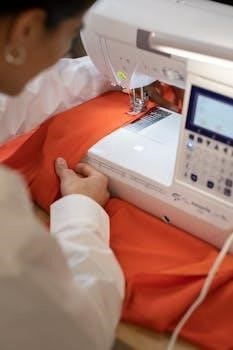User manuals are crucial for understanding your sewing machine. They offer step-by-step instructions, ensuring correct operation, safety, and maintenance. These manuals often come in PDF format, making them easily accessible for download.
Importance of User Manuals
Sewing machine user manuals are indispensable tools for both beginners and experienced sewers. They provide detailed guidance on how to operate specific models safely and effectively. These manuals are not just for initial setup; they are valuable resources for troubleshooting common issues, performing routine maintenance, and exploring advanced features. A good manual will guide you through threading your machine, winding the bobbin, and adjusting stitch settings. Furthermore, they offer essential safety precautions that help prevent accidents and ensure longevity of the machine. Many manufacturers provide free downloadable manuals, making it easy to access necessary information quickly. Having a user manual readily available is crucial for maximizing your machine’s potential and achieving the best sewing results. They offer peace of mind and prevent misuse of the equipment.
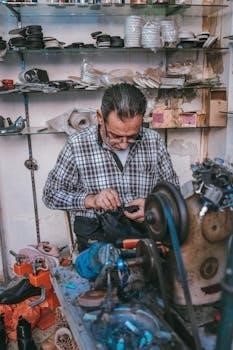
Understanding Your Sewing Machine
Familiarizing yourself with your sewing machine’s parts and their functions is essential. This knowledge ensures safe and effective operation for all your sewing projects and helps extend its life.
Identifying Machine Parts
Understanding the various components of your sewing machine is vital for smooth operation. Key parts include the needle, which pierces the fabric; the presser foot, holding fabric in place; and the bobbin, supplying thread from below. The thread spindle holds the thread spool, while the tension dial regulates thread tightness. The handwheel allows manual needle movement, and the stitch selector lets you choose different stitch patterns. Familiarizing yourself with these parts and their functions will greatly enhance your sewing experience. Additionally, the feed dogs move the fabric, and the throat plate surrounds the needle. Learning each part helps prevent issues.
Basic Operation Overview
Operating a sewing machine involves several key steps. Begin by ensuring the machine is properly threaded, both the upper thread and the bobbin. Next, select your desired stitch pattern and adjust the stitch length and width as needed. Place your fabric under the presser foot, and lower the foot. Start sewing by gently pressing the foot pedal, maintaining consistent pressure for even stitching. Guide the fabric smoothly, avoiding pulling or pushing it. Remember to stop with the needle in the down position before lifting the presser foot to turn or remove your fabric. Practice these basic steps for confident sewing.
Safety Precautions
Always read safety instructions before operating. Keep fingers away from moving parts. Use recommended accessories only. Ensure proper threading and fabric placement to prevent accidents.
Essential Safety Instructions
Prior to using your sewing machine, thoroughly review the safety guidelines detailed in the user manual. Always disconnect the machine from power when changing needles or performing maintenance. Keep children and pets away from the machine while it is in use. Never operate the machine if any parts are damaged or missing. Ensure your workspace is well-lit and free of clutter. Avoid wearing loose clothing or jewelry that could get caught in the machine’s moving parts. Only use accessories specifically designed for your model. Be sure the machine is correctly threaded and the fabric is properly positioned before you start sewing. Pay close attention to warnings within the manual.
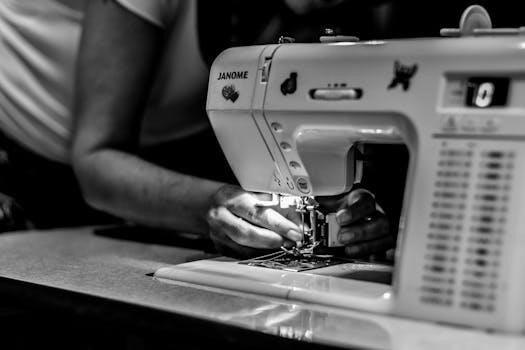
Threading Your Sewing Machine
Proper threading is essential for sewing. The manual provides a step-by-step guide for threading the upper thread and winding the bobbin, ensuring smooth operation and avoiding jams.
Step-by-Step Threading Guide
The threading process, detailed in your manual, typically starts with placing the thread spool on the designated pin. Next, guide the thread through the tension discs and take-up lever, following the machine’s specific path. Ensure the thread passes through all guides before leading it to the needle. This precise routing is crucial for consistent stitch formation. The manual will show you exactly how to navigate your specific model, as different machines may vary slightly. Refer to your manual carefully, following the illustrations and numbered steps for a successful thread-up. A properly threaded machine is key to avoid skipped stitches and other sewing issues. Consult your manual for detailed diagrams.
Bobbin Winding Instructions
Bobbin winding, essential for sewing, is detailed in your sewing machine’s manual. It begins by placing the empty bobbin onto the bobbin winder pin. Next, guide the thread from the spool through the bobbin winding tension disc. Engage the bobbin winding mechanism, as per your machine’s design. Start the machine, allowing it to wind thread evenly onto the bobbin, often with an automatic stop when full. The manual provides specific directions, often with diagrams, for your machine. Uneven winding can cause issues, so follow the manual closely. Ensure the thread isn’t too tight or loose, as the manual will advise for optimum results.
Basic Sewing Techniques
Mastering basic techniques is key. User manuals guide you through starting and ending seams, adjusting stitch length and width, and other fundamental sewing procedures for successful projects.
Starting and Ending a Seam
A crucial aspect of sewing is understanding how to start and end a seam correctly. Begin by positioning your fabric under the presser foot, aligning it with the desired seam allowance. Lower the presser foot and gently start sewing, using a few reverse stitches to secure the beginning of the seam. This prevents unraveling. Continue sewing at a consistent pace, guiding the fabric smoothly. When you reach the end of your seam, sew a few reverse stitches again to lock the thread. Finally, lift the presser foot and carefully remove your fabric from the machine, trimming any excess threads. This ensures a secure and professional finish.
Adjusting Stitch Length and Width
Understanding how to adjust stitch length and width is essential for various sewing projects. Stitch length refers to the distance between each stitch, while stitch width is mainly for zigzag stitches, indicating how wide the stitch is. Most sewing machines have dials or buttons to control these settings. For delicate fabrics, a shorter stitch length is often preferred to prevent puckering, while thicker materials may require a longer stitch length. Similarly, a narrow stitch width is suitable for straight seams, while wider widths are used for decorative stitches. Experimenting with different settings will allow you to achieve the desired look and functionality for your sewing project.
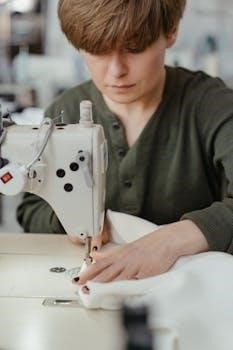
Maintenance and Troubleshooting
Regular maintenance ensures smooth operation. Troubleshooting guides help resolve common issues, such as thread jams or skipped stitches. Service manuals provide more technical repair information.
Routine Maintenance Procedures
Regular cleaning is essential for optimal sewing machine performance. Remove lint and thread buildup from the bobbin area and feed dogs using a small brush. Lubricate moving parts with sewing machine oil as recommended in your manual to reduce friction and wear. Check and replace needles frequently to prevent damage and maintain stitch quality. Inspect and tighten screws to ensure stability. Following these routine steps will extend the lifespan of your machine and prevent many common issues. Consult your specific manual for the recommended frequency and specific areas to address for your particular model. Regular care will lead to a smoother sewing experience.
Troubleshooting Common Issues
Experiencing skipped stitches? Ensure the needle is correctly installed and not bent. Thread breakage often stems from improper threading or using the wrong type of thread. Fabric bunching can occur from incorrect tension settings. Check your manual for specific tension recommendations and adjust accordingly. If your machine is jamming, clean the bobbin area and check for obstructions. A noisy machine might indicate a need for lubrication or loose parts. Consult your manual for detailed troubleshooting guidance and identify the cause of these common problems. Always double-check the basics before diving into more complex solutions. Most issues can be solved by carefully following your manual’s advice.
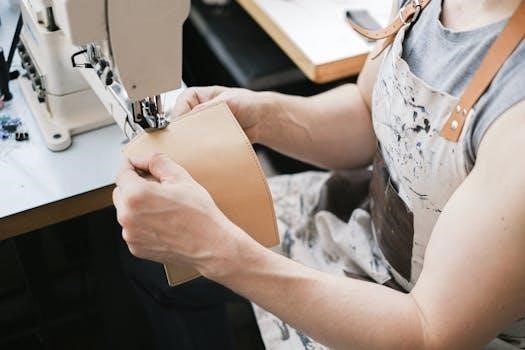
Finding Manuals Online
Locate your sewing machine manual by searching online with the brand and model number. Many manufacturers offer free PDF downloads of their manuals on their websites.
How to Locate Your Model’s Manual
To find your sewing machine’s specific manual, begin by identifying the brand and model number. This information is usually found on a label on the machine itself. Next, visit the manufacturer’s website and look for a “Support” or “Manuals” section. If it’s an older model, search for a “Retired” or “Legacy” section. Alternatively, use a search engine with keywords like “[Brand] sewing machine manual PDF” or “[Brand] [Model Number] manual”. Many sites provide free downloads. You can also explore online sewing communities for assistance or shared resources. Remember to verify the source to ensure you are accessing a legitimate manual and not a copy.
Downloading PDF Manuals
Once you have located your sewing machine’s manual online, downloading it as a PDF is usually straightforward. Look for a download button or link, often labeled “Download PDF” or similar. Click this link to start the download process. The PDF file will save to your device’s designated download folder. Ensure your device has a PDF reader installed to open and view the manual. It’s advisable to save the downloaded manual in a safe, accessible location for future reference. Be cautious when downloading from unfamiliar sites and always ensure the source is legitimate to avoid malicious software. Having a digital copy allows you to view the manual on various devices or print it out if desired.
Advanced Features
Many sewing machines offer special stitches and attachments. User manuals detail how to use these features. These may include decorative stitches, buttonholes, and various presser feet for specific tasks.
Exploring Special Stitches
Modern sewing machines frequently come equipped with a variety of special stitches beyond the basic straight and zigzag. These can include decorative stitches, stretch stitches, overlock stitches, and buttonhole options. The user manual is your guide to understanding how to select and utilize these stitches. It will usually explain the purpose of each stitch, how to adjust stitch length and width, and what type of fabric each stitch is best suited for. Mastering these special stitches can significantly elevate your sewing projects, allowing for more creative and professional-looking results. The manual will also provide important tips for achieving optimal performance with each unique stitch, such as proper tension and thread selection, so that you can achieve the best results.
Using Additional Attachments
Many sewing machines come with, or offer optional, additional attachments that expand their functionality. These can include various presser feet for zippers, buttonholes, hemming, and quilting, as well as attachments for gathering, binding, and other specialized techniques. The user manual is crucial for understanding how to correctly install and use these attachments. It will detail the specific purpose of each attachment, along with the recommended settings and techniques. Utilizing these attachments effectively can significantly enhance the versatility of your sewing machine, making complex tasks easier and more precise. Always consult the manual before using any new attachment to avoid damage to your machine or incorrect usage. The manual will guide you through optimal settings for the best outcomes.
